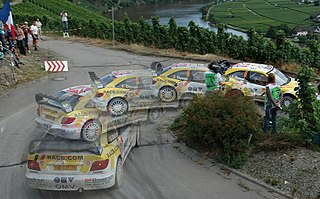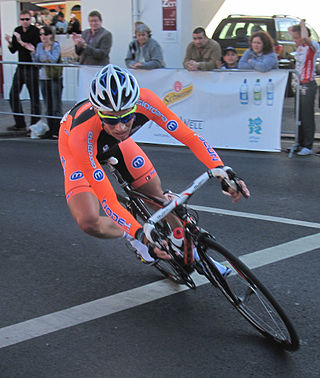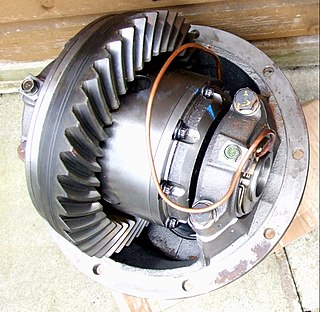Heel-and-toe shifting is an advanced driving technique used mostly in performance driving with a manual gearbox, although some drivers use it on the road in everyday conditions in the interest of effectiveness. It involves operating the throttle and brake pedals simultaneously with the right foot, while facilitating normal activation of the clutch with the left foot. It is used when braking and downshifting simultaneously, and allows the driver to "blip" the throttle to raise the engine speed and smoothly engage the lower gear.
Left-foot braking is the technique of using the left foot to operate the brake pedal in an automobile, leaving the right foot dedicated to the throttle pedal. It contrasts with the practice of using the left foot to operate the clutch pedal, leaving the right foot to share the duties of controlling both brake and gas pedals.

Opposite lock, also commonly known as countersteer, is a colloquial term used to mean the steering associated with the deliberate use of oversteer to turn a vehicle rapidly without losing momentum. It is typified by the classic rallying style of rear-wheel drive cars, where a car travels around a bend with a large drift angle. The terms "opposite lock" and "counter-steering" refer to the position of the steering wheel during the maneuver, which is turned in the opposite direction to that of the bend.

The handbrake turn is a driving technique used to deliberately slide a car sideways, either for the purpose of quickly negotiating a very tight bend, or for turning around well within the vehicle's own turning diameter.

Steering is the control of the direction of locomotion or the components that enable its control. Steering is achieved through various arrangements, among them ailerons for airplanes, rudders for boats, tilting rotors for helicopters, and many more.

Cruise control is a system that automatically controls the speed of an automobile. The system is a servomechanism that takes over the throttle of the car to maintain a steady speed as set by the driver.
A traction control system (TCS), is typically a secondary function of the electronic stability control (ESC) on production motor vehicles, designed to prevent loss of traction of the driven road wheels. TCS is activated when throttle input and engine power and torque transfer are mismatched to the road surface conditions.

A manual transmission (MT), also known as manual gearbox, standard transmission, or stick shift, is a multi-speed motor vehicle transmission system, where gear changes require the driver to manually select the gears by operating a gear stick and clutch.
Automobile handling and vehicle handling are descriptions of the way a wheeled vehicle responds and reacts to the inputs of a driver, as well as how it moves along a track or road. It is commonly judged by how a vehicle performs particularly during cornering, acceleration, and braking as well as on the vehicle's directional stability when moving in steady state condition. Numerous factors affect handling

A locking differential is a mechanical component, commonly used in vehicles, designed to overcome the chief limitation of a standard open differential by essentially "locking" both wheels on an axle together as if on a common shaft. This forces both wheels to turn in unison, regardless of the traction available to either wheel individually.

Drifting is a driving technique where the driver intentionally oversteers, with loss of traction, while maintaining control and driving the car through the entirety of a corner or a turn. The technique causes the rear slip angle to exceed the front slip angle to such an extent that often the front wheels are pointing in the opposite direction to the turn. Drifting is traditionally performed using three methods: clutch kicking, weight transfer, and employing a handbrake turn. This sense of drift is not to be confused with the four wheel drift, a classic cornering technique established in Grand Prix and sports car racing.
A bootleg turn is a driving maneuver intended to reverse the direction of travel of a forward-moving automobile by 180 degrees in a minimum amount of time while staying within the width of a two-lane road. This maneuver is also known as a smuggler's turn, powerslide, or simply bootlegger.

Trail braking is a driving and motorcycle riding technique where the brakes are used beyond the entrance to a turn (turn-in), and then gradually released. Depending on a number of factors, the driver fully releases brake pressure at any point between turn-in and the apex of the turn.

Fishtailing is a vehicle handling problem which occurs when the rear wheels lose traction, resulting in oversteer. This can be caused by low-friction surfaces. Rear-drive vehicles with sufficient power can induce this loss of traction on any surface, which is called power-oversteer.
Lift-off oversteer is a form of sudden oversteer. While cornering, a driver who closes the throttle, usually at a high speed, can cause such sudden deceleration that the vertical load on the tires shifts from rear to front, in a process called load transfer. This decrease in vertical load on the rear tires in turn decreases their traction by lowering their lateral force, making the vehicle steer more tightly into the turn. In other words, easing off the accelerator in a fast turn can cause a car's rear tires to loosen their grip so much that the driver loses control and drifts outwards, even leaving the road tailfirst.
A wheelspin occurs when the force delivered to the tire tread exceeds that of available tread-to-surface friction and one or more tires lose traction. This leads the wheels to "spin" and causes the driver to lose control over the tires that no longer have grip on the road surface. Wheelspin can also be done intentionally such as in drifting or doing a burnout.
Active steering describes a steering system for a vehicle in which the relationship between the driver’s steer inputs and the angle of the steered road wheels may be continuously and intelligently altered. Whilst active steering systems may be found in agricultural equipment and heavy plant, this article concentrates on the application of active steering in BMW passenger cars.
All Wheel Control (AWC) is the brand name of a four-wheel drive (4WD) system developed by Mitsubishi Motors. The system was first incorporated in the 2001 Lancer Evolution VII. Subsequent developments have led to S-AWC (Super All Wheel Control), developed specifically for the new 2007 Lancer Evolution. The system is referred by the company as its unique 4-wheel drive technology umbrella, cultivated through its motor sports activities and long history in rallying spanning almost half a century.

Car controls are the components in automobiles and other powered road vehicles, such as trucks and buses, used for driving and parking.












